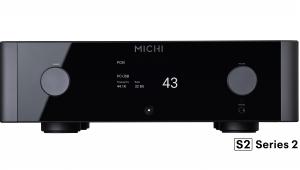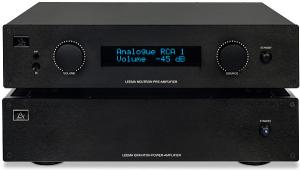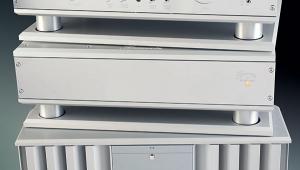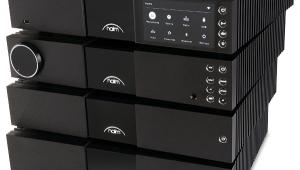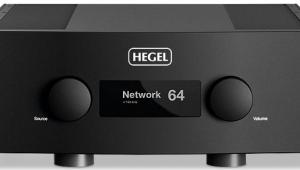Cambridge Audio Azur 840e/840w (£800/£1200)
Some electronics manufacturers manage to move upmarket just by adding more elaborate casework, a few audiophile components and, if you are lucky, a bigger transformer.
Not so with the Cambridge Azur range. With these products, it seems the company set out to leapfrog the competition in technology and technical performance. And so, at the top of the Azur line, we have a truly sophisticated preamp, the 840E, and a truly muscular power amp, the 840W, at a total price of £2000. Is it all too good to be true?
Essentially, despite its complexity, the 840E is easy to use just by picking up the remote. Extra features and setup options are accessed via the menu system, either from the remote or the front panel buttons.
Cambridge has chosen an elaborate no-compromise volume control, using precision resistor ladders switched by relays and accessible by remote control. So volume adjustment is accompanied by an audible clicking of relays, the level shown in the display as a large –dB figure with a neat semicircle graphic around it. Normally, if you switch into Standby, the preamp will rapidly re-set itself to minimum level with a sound like a rattlesnake in a TV western.
Returning from Standby, the volume level will rattlesnake up again to the previous setting. If you don’t want this to happen, the Volume Ramp feature can be turned off via the setup menu. Volume then remains as set when in standby.
DIRECT SIGNAL
Tone controls are brought up by pressing the Mode button, then scrolling through bass, treble and balance screens. Settings can be stored for each input, using the volume control to make the adjustment. But you can use the 840E as a ‘minimalist’ preamp, keeping tone controls switched out for any input via the front-panel Direct button (not duplicated on the remote).
A longer press on the Mode button takes you to the System Configure menu. Here you can for example adjust levels input levels to give equal loudness from different sources, set the brightness of the display, or as already mentioned disable the volume-ramp feature.
On the back of the preamp are eight sets of standard unbalanced inputs (including Tape) plus balanced inputs for Inputs 1 and 2, selected by toggle switches. Along with the stereo outputs, there is an (unbalanced) mono Sub output, with a switchable 200Hz low-pass filter.
Other connections include an RS232C port, IR input, 5-12V Trigger and control bus for custom install, as well as A-Bus/Incognito Ready outputs for Cambridge’s own Incognito multi-room system.
At 19.6kg, the 840W is a real heavyweight, its sturdy casework unusually well ventilated because Cambridge’s ‘Class XD’ amplification produces more heat than the standard Class AB. As well as unbalanced inputs and doubled-up speaker binding posts, the back panel carries balanced inputs, selected by toggle switches.
Two further switches turn the stereo 840W into a dual mono power amplifier for bi-amping, or alternatively convert it to bridged mono mode, giving a single output of around 500W. Finally, there are Control Bus, Trigger In and Out/Thru and IR In connections.
On arrival, our early 840W sample produced a slight hum through the speakers, not serious but not as intended. A second sample was better in this respect.
GET ON BOARD
Spinning up Eric Bibb’s Get Onboard [Telarc CD-83675] it was soon obvious that the Cambridge combination could create a big, open and relaxed soundstage. Bass was well controlled, and the kick drum and bass starting every bar on ‘God’s Kingdom’ came over well, expansive but not overstated. There was a happy wealth of detail too, from the skeetering of the slide on the strings of a steel guitar or the intimate breath sound of the harmonica. In Jennifer Warnes’ Famous Blue Raincoat [RTHCD 5052] I was struck by the way the Cambridge combination pulled detail out of a complex mix, and the way the system now presented Warnes’ voice with all its finely-controlled shifts of colour. Meanwhile, the drummer’s insistent offbeat sounded human, rather than mechanical, with some feeling of air round it.
Pulling out Kind Of Blue [Sony 480410 2], once again, there was control and freedom from exaggeration in the bass, and when Paul Chambers broke into a walking bass pattern after the theme statement, it was easy to hear his most fleeting double notes. And tiny details again illustrated the amp’s abilities, the liquid-sounding ‘plop’ of brush on cymbal, or the way the studio ambience was so easily separable from the notes in Miles’ solo.
FREE OF STRAIN
So to an acid test, the LSO’s Barbican recording of Beethoven’s Symphony 5 with Bernard Haitink [LSO Live LSO 0590]. Without taking any special care to set the volume, the Cambridge amp handled the dynamics well, and the music came flooding into the room without strain. Even the biggest crescendos did not induce that involuntary ear-closure that happens, I think, when an inadequate amplifier runs out of steam.
With its balanced operation, electronic controls and state-of-the-art volume control, the 840E is versatile and very good value. The 840E/840W combo offers great imaging and smoothness, and enough watts to give a good feeling of dynamic headroom with averagely-sensitive speakers. Cambridge has come up with a one-two punch that will be hard to beat.
VERDICT
You can sense Cambridge Audio is on a mission. Just as the Azur 840 and Azur 740 CD players out-upsampled their rivals, the top-of-the-range Azur amplifier combination seems to pack in more technology and, in the case of the beefy 840W, more power than you’d expect at the price. It would be impossible not to recommend this impressive combination.
Originally published in the August 2008 issue





